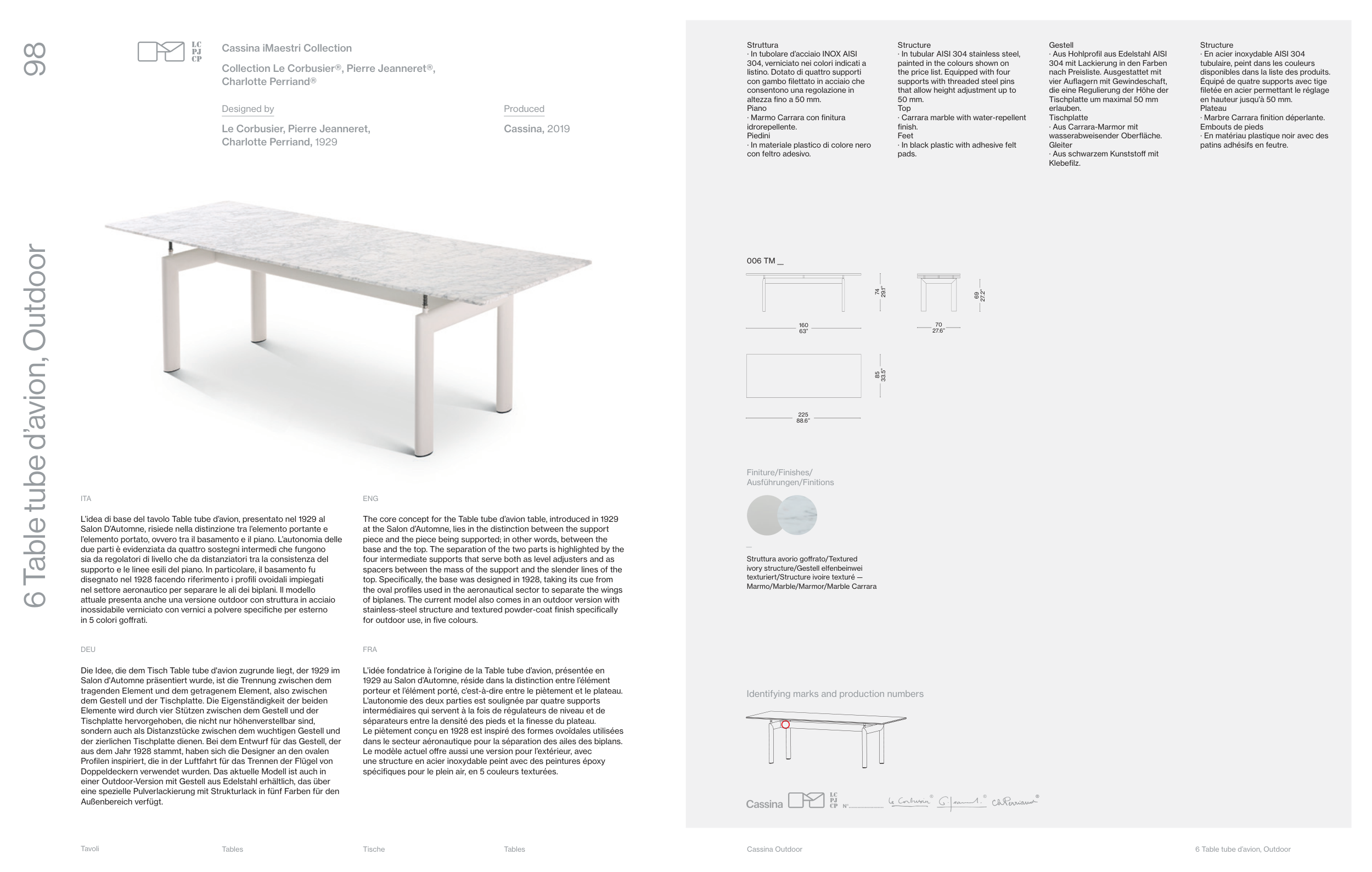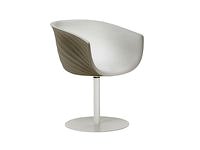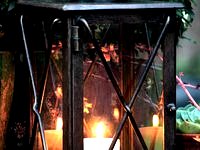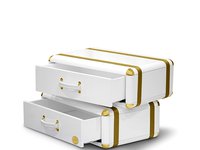6 Table tube d’avion, Outdoor
Designed by
Le Corbusier, Pierre Jeanneret,
Charlotte Perriand, 1929
Produced
Cassina, 2019
Identifying marks and production numbers
006 TM __
70
27.6”
74
29.1”
85
33.5”
69
27.2”
160
63”
225
88.6”
Finiture/Finishes/
Ausführungen/Finitions
Struttura avorio goffrato/Textured
ivory structure/Gestell elfenbeinwei
texturiert/Structure ivoire texturé —
Marmo/Marble/Marmor/Marble Carrara
Struttura
· In tubolare d’acciaio INOX AISI
304, verniciato nei colori indicati a
listino. Dotato di quattro supporti
con gambo filettato in acciaio che
consentono una regolazione in
altezza fino a 50 mm.
Piano
· Marmo Carrara con finitura
idrorepellente.
Piedini
· In materiale plastico di colore nero
con feltro adesivo.
Gestell
· Aus Hohlprofil aus Edelstahl AISI
304 mit Lackierung in den Farben
nach Preisliste. Ausgestattet mit
vier Auflagern mit Gewindeschaft,
die eine Regulierung der Höhe der
Tischplatte um maximal 50 mm
erlauben.
Tischplatte
· Aus Carrara-Marmor mit
wasserabweisender Oberfläche.
Gleiter
· Aus schwarzem Kunststoff mit
Klebefilz.
Structure
· In tubular AISI 304 stainless steel,
painted in the colours shown on
the price list. Equipped with four
supports with threaded steel pins
that allow height adjustment up to
50 mm.
Top
· Carrara marble with water-repellent
finish.
Feet
· In black plastic with adhesive felt
pads.
Structure
· En acier inoxydable AISI 304
tubulaire, peint dans les couleurs
disponibles dans la liste des produits.
Équipé de quatre supports avec tige
filetée en acier permettant le réglage
en hauteur jusqu'à 50 mm.
Plateau
· Marbre Carrara finition déperlante.
Embouts de pieds
· En matériau plastique noir avec des
patins adhésifs en feutre.
L’idea di base del tavolo Table tube d’avion, presentato nel 1929 al
Salon D’Automne, risiede nella distinzione tra l’elemento portante e
l’elemento portato, ovvero tra il basamento e il piano. L’autonomia delle
due parti è evidenziata da quattro sostegni intermedi che fungono
sia da regolatori di livello che da distanziatori tra la consistenza del
supporto e le linee esili del piano. In particolare, il basamento fu
disegnato nel 1928 facendo riferimento i profili ovoidali impiegati
nel settore aeronautico per separare le ali dei biplani. Il modello
attuale presenta anche una versione outdoor con struttura in acciaio
inossidabile verniciato con vernici a polvere specifiche per esterno
in 5 colori goffrati.
The core concept for the Table tube d’avion table, introduced in 1929
at the Salon d’Automne, lies in the distinction between the support
piece and the piece being supported; in other words, between the
base and the top. The separation of the two parts is highlighted by the
four intermediate supports that serve both as level adjusters and as
spacers between the mass of the support and the slender lines of the
top. Specifically, the base was designed in 1928, taking its cue from
the oval profiles used in the aeronautical sector to separate the wings
of biplanes. The current model also comes in an outdoor version with
stainless-steel structure and textured powder-coat finish specifically
for outdoor use, in five colours.
Die Idee, die dem Tisch Table tube d'avion zugrunde liegt, der 1929 im
Salon d'Automne präsentiert wurde, ist die Trennung zwischen dem
tragenden Element und dem getragenem Element, also zwischen
dem Gestell und der Tischplatte. Die Eigenständigkeit der beiden
Elemente wird durch vier Stützen zwischen dem Gestell und der
Tischplatte hervorgehoben, die nicht nur höhenverstellbar sind,
sondern auch als Distanzstücke zwischen dem wuchtigen Gestell und
der zierlichen Tischplatte dienen. Bei dem Entwurf für das Gestell, der
aus dem Jahr 1928 stammt, haben sich die Designer an den ovalen
Profilen inspiriert, die in der Luftfahrt für das Trennen der Flügel von
Doppeldeckern verwendet wurden. Das aktuelle Modell ist auch in
einer Outdoor-Version mit Gestell aus Edelstahl erhältlich, das über
eine spezielle Pulverlackierung mit Strukturlack in fünf Farben für den
Außenbereich verfügt.
L’idée fondatrice à l’origine de la Table tube d’avion, présentée en
1929 au Salon d’Automne, réside dans la distinction entre l’élément
porteur et l’élément porté, c’est-à-dire entre le piètement et le plateau.
L’autonomie des deux parties est soulignée par quatre supports
intermédiaires qui servent à la fois de régulateurs de niveau et de
séparateurs entre la densité des pieds et la finesse du plateau.
Le piètement conçu en 1928 est inspiré des formes ovoïdales utilisées
dans le secteur aéronautique pour la séparation des ailes des biplans.
Le modèle actuel offre aussi une version pour l’extérieur, avec
une structure en acier inoxydable peint avec des peintures époxy
spécifiques pour le plein air, en 5 couleurs texturées.
ITA
ENG
DEU
FRA
Cassina iMaestri Collection
Collection Le Corbusier®, Pierre Jeanneret®,
Charlotte Perriand®
98
6 Table tube d’avion, Outdoor
Cassina Outdoor
Tavoli
Tables
Tische
Tables































































































